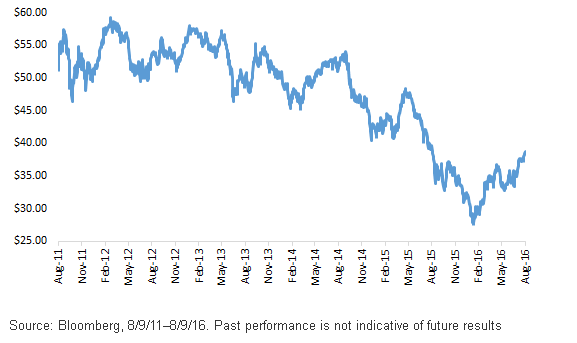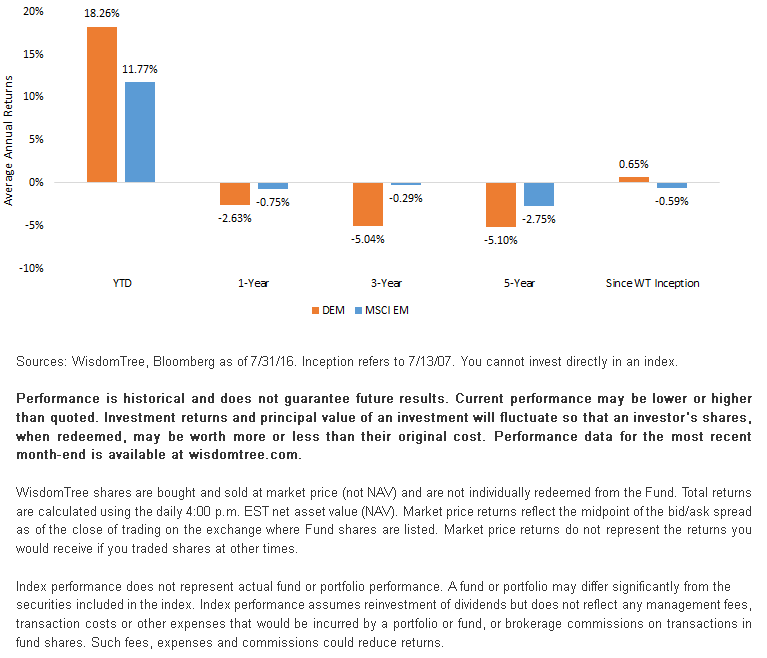Why This Emerging Market Dividend Strategy Outperformed


 While emerging markets have certainly been out of favor, and DEM in particular had a rough stretch in 2013–2015, its position in high-dividend stocks has paid off in 2016 when measured on a relative basis to the MSCI Emerging Markets Index.
DEM is a strategy that looks for value and inexpensive stocks in emerging markets, and it has found those stocks in the last few years in commodity sectors including Energy and Materials and countries such as Brazil and Russia. These two commodity sectors receive about one-third of the exposure of DEM, approximately double the exposure in the MSCI Emerging Markets Index.1 This is the part of the market that has performed quite well in 2016 after a few years of disappointing returns.
Emerging Market Performance
While emerging markets have certainly been out of favor, and DEM in particular had a rough stretch in 2013–2015, its position in high-dividend stocks has paid off in 2016 when measured on a relative basis to the MSCI Emerging Markets Index.
DEM is a strategy that looks for value and inexpensive stocks in emerging markets, and it has found those stocks in the last few years in commodity sectors including Energy and Materials and countries such as Brazil and Russia. These two commodity sectors receive about one-third of the exposure of DEM, approximately double the exposure in the MSCI Emerging Markets Index.1 This is the part of the market that has performed quite well in 2016 after a few years of disappointing returns.
Emerging Market Performance
 DEM passed its nine-year anniversary in July. While the strategy was out of favor for a few years, the long-term track record remains quite robust, showing an outperformance of over 100 basis points (bps) per year since the Fund’s inception.
What Drove This Long-Term Outperformance?
Managing valuation risk is a key element of many WisdomTree exchange-traded funds (ETFs), because the WisdomTree Indexes that the funds are designed to track incorporate a relative value rebalance. Let’s take a closer look at the type of relative value rebalance that the Index DEM is designed to track undergoes.
We are coming up on the annual emerging markets rebalance in October, which will look at stocks becoming more expensive relative to their dividends. The WisdomTree Index process is designed to reduce weight in those stocks that have become more expensive (whose prices are appreciating more than dividends) while adding to weight in stocks that are becoming relatively less expensive (whose prices are falling more than dividends or whose dividends are growing relative to prices).
We believe this process has added value in terms of higher returns over the long run compared to traditional indexes. Recent conditions for emerging markets, with volatility and downward price moves, are key times when the WisdomTree Index family looks to buy the lower valuation segment of the market, in which prices were falling more than dividends. As some of the markets rebound strongly this year, the WisdomTree Index will become more defensive and sell the stocks that are increasing more than their underlying fundamentals.
There were years like 2008 and 2011, which were marked by large losses in emerging markets, where DEM showed its defensive properties, declining less than broader emerging market indexes.
The Fund has rebalanced into areas with relatively low valuations—energy and materials in particular—as the markets went out of favor, and it is just starting to benefit from this positioning in 2016.
Given the valuations across global markets, the emerging markets remain one of most attractively priced parts of the world and the high-dividend stock selection strategy in particular is a lower valuation way to own this market segment, in our view.
1Sources: WisdomTree, Bloomberg as of 7/31/16.
DEM passed its nine-year anniversary in July. While the strategy was out of favor for a few years, the long-term track record remains quite robust, showing an outperformance of over 100 basis points (bps) per year since the Fund’s inception.
What Drove This Long-Term Outperformance?
Managing valuation risk is a key element of many WisdomTree exchange-traded funds (ETFs), because the WisdomTree Indexes that the funds are designed to track incorporate a relative value rebalance. Let’s take a closer look at the type of relative value rebalance that the Index DEM is designed to track undergoes.
We are coming up on the annual emerging markets rebalance in October, which will look at stocks becoming more expensive relative to their dividends. The WisdomTree Index process is designed to reduce weight in those stocks that have become more expensive (whose prices are appreciating more than dividends) while adding to weight in stocks that are becoming relatively less expensive (whose prices are falling more than dividends or whose dividends are growing relative to prices).
We believe this process has added value in terms of higher returns over the long run compared to traditional indexes. Recent conditions for emerging markets, with volatility and downward price moves, are key times when the WisdomTree Index family looks to buy the lower valuation segment of the market, in which prices were falling more than dividends. As some of the markets rebound strongly this year, the WisdomTree Index will become more defensive and sell the stocks that are increasing more than their underlying fundamentals.
There were years like 2008 and 2011, which were marked by large losses in emerging markets, where DEM showed its defensive properties, declining less than broader emerging market indexes.
The Fund has rebalanced into areas with relatively low valuations—energy and materials in particular—as the markets went out of favor, and it is just starting to benefit from this positioning in 2016.
Given the valuations across global markets, the emerging markets remain one of most attractively priced parts of the world and the high-dividend stock selection strategy in particular is a lower valuation way to own this market segment, in our view.
1Sources: WisdomTree, Bloomberg as of 7/31/16.
Important Risks Related to this Article
There are risks associated with investing, including possible loss of principal. Foreign investing involves special risks, such as risk of loss from currency fluctuation or political or economic uncertainty. Funds focusing on a single sector generally experience greater price volatility. Investments in emerging, offshore or frontier markets are generally less liquid and less efficient than investments in developed markets and are subject to additional risks, such as risks of adverse governmental regulation, intervention and political developments. Due to the investment strategy of this Fund, it may make higher capital gain distributions than other ETFs. Please read the Fund’s prospectus for specific details regarding the Fund’s risk profile.
Dividends are not guaranteed, and a company currently paying dividends may cease paying dividends at any time.
Commodities are generally volatile and are not suitable for all investors.

Jeremy Schwartz has served as our Global Chief Investment Officer since November 2021 and leads WisdomTree’s investment strategy team in the construction of WisdomTree’s equity Indexes, quantitative active strategies and multi-asset Model Portfolios. Jeremy joined WisdomTree in May 2005 as a Senior Analyst, adding Deputy Director of Research to his responsibilities in February 2007. He served as Director of Research from October 2008 to October 2018 and as Global Head of Research from November 2018 to November 2021. Before joining WisdomTree, he was a head research assistant for Professor Jeremy Siegel and, in 2022, became his co-author on the sixth edition of the book Stocks for the Long Run. Jeremy is also co-author of the Financial Analysts Journal paper “What Happened to the Original Stocks in the S&P 500?” He received his B.S. in economics from The Wharton School of the University of Pennsylvania and hosts the Wharton Business Radio program Behind the Markets on SiriusXM 132. Jeremy is a member of the CFA Society of Philadelphia.

